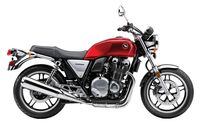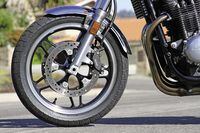PHOTOS: Kevin Wing
They say: "Timeless look, inspired performance."
We say: "Half the guys who see it won't know it's new."
At a time when so many retro bikes center on Honda hardware, it’s ironic that the company itself has shied away from the old-is-new angle for the last decade. In 1999, Honda displayed the CB Four concept bike at the Tokyo Motor Show, an amazingly tight interpretation of the CB750K with an air-cooled inline-four engine, wire wheels, and rubber fork gaiters. Honda teased but never delivered.
The classic proportions are all there, with the added treat of a CB400F-esque four-into-one pipe.
Eight years later, Honda once again brought out a rolling homage to the CB750. At the 2007 Tokyo show, Honda taunted old guys with the CB1100F concept bike. Now more modern looking with cast wheels in contemporary sizes and a blockier fuel tank, it still embraced an across-the-frame four with prominent cooling fins. Think of the CB series from the 1970s and ‘80s, starting with the CB750F and continuing through the CB900F and to the CB1100F, a one-year-only special. Rather than a straight repro, Honda’s 2007 showbike had the aura of a familiar movie star with a little bit of work done.
Honda eventually produced the CB1100, but only for Japan and Australia. Good news is here: Honda will deliver the CB1100 to our fruited plain as a 2013 model, with deliveries starting in March.
The bike we’ll get is remarkably close to the ’07 concept and virtually identical to the worldwide production model. Close examination reveals a different tank shape than the showbike’s—it’s more rounded at the leading edge and is less blocky where it meets the smooth, single-piece saddle. Still, it’s not a big tank, just 3.8 gallons, but that was part of the design. According to Honda, the CB1100 was meant to be sized like a 750—a scale smaller than the last of the air-cooled literbikes.
Clean, unencumbered lines recall the classic Universal Japanese Motorcycle of the 1970s. Honda's pegged it with the CB1100.
Why not a true 750, then? Honda stuck resolutely with air cooling—or, at least, a hybrid, using a considerable amount of oil cooling and a discreetly located cooler—and that, along with a desire for a strong, flat torque curve, suggested a larger engine in a mild state of tune. Which is what we got: An 1140cc, DOHC, four-valve-per-cylinder engine that’s totally new but uses architecture straight out of the ’70s. Those cams are driven by a central chain; an alternator hangs off the left end of the crank; and power wends back to the rear wheel through a five-speed gearbox and chain final drive. Even the cam covers were styled to resemble those used on the CB750/900/1100 series.
Honda gave us the briefest tease of the CB1100 a few days before a press conference held at the company’s museum in Torrance, CA. And we mean brief: Perhaps 30 miles in the suburbs surrounding the company’s U.S. headquarters. No highway, no real twisty roads, but enough seat time to whet our appetite and provide the barest of first impressions.
The engine’s overarching attribute is its easygoing nature. Because of the single balance shaft and two rubber engine mounts, it’s a smooth operator, completely lacking the classic inline-four tingle that made the CB750 famous—or infamous, if your extremities are still a bit numb. Throttle response from the electronic fuel injection is creamy, even without secondary butterflies to smooth power delivery. Torque ramps up nicely by 1500 rpm and seems to peak early. Honda says the torque peak of 68.6 lb.-ft. occurs at just 5000 rpm (with a max of 88.5 horsepower at 7500 rpm), and the bike feels just that way. From the torque peak to the 8500-rpm redline, anticipate diminishing returns. Sure, you can wring it out, but the engine loves to loaf, turning slightly buzzy above 6500 rpm as a way of saying, “Slow down, son. You’re not 20 any more.” The wide-ratio transmission allows you to stay in the comfort zone to highway speeds—who needs sixth gear? Accompanying your endeavors is a dignified whoosh from the airbox and barely a sizzle from the CB400F-esque exhaust.
Modern brakes are part of the CB1100 package, with ABS a $1000 option.
It’s hard to judge the chassis on such a short ride, but first impressions are positive. The CB1100 rolls on 18-inch radial tires, narrow by modern sportbike standards, and that may explain the light, accurate steering. So, too, do the widely spaced handgrips that are maybe an inch or two too close to the rider—leverage is your friend. One surprise is the footpeg location, which is higher and farther rearward than expected, giving the CB a slightly European feel. In fact, this bike is one superbike-bend handlebar away from ergonomic perfection.
“Balance” best describes the rest of the chassis. Four-piston Nissin binders are part of the non-ABS package (you get six-piston Nissins with the Combined ABS option) and provide great feel and appropriate power. The suspension is on the soft side but well controlled—the chassis doesn’t pitch much, and small bumps are mostly consumed on the way to the rider. Adjustments include spring preload for the 41mm, non-cartridge fork and twin shocks. That’s it.
Young punks will probably call the 546-pound CB1100 porky and slow. Elder statesmen will take one look at the CB’s style, run a hand along the tank, and let their nostalgia write a check for $9999—$10,999 with ABS—without thinking twice.


















/cloudfront-us-east-1.images.arcpublishing.com/octane/HXOUJXQWA5HBHGRO3EMJIGFMVI.jpg)

/cloudfront-us-east-1.images.arcpublishing.com/octane/3TIWWRV4JBBOLDVGRYECVVTA7Y.jpg)
/cloudfront-us-east-1.images.arcpublishing.com/octane/KIX5O23D5NAIBGFXBN3327DKZU.jpg)
/cloudfront-us-east-1.images.arcpublishing.com/octane/7GJYDUIPXRGMTMQKN6ONYOLBOU.jpg)
/cloudfront-us-east-1.images.arcpublishing.com/octane/MUQLOVLL2ZDGFH25ILABNBXKTI.jpg)
/cloudfront-us-east-1.images.arcpublishing.com/octane/TNOU5DNE2BC57MFPMGN2EIDXAM.jpg)
/cloudfront-us-east-1.images.arcpublishing.com/octane/GTCXACQGJ5HAPDTGWUQKDEH44E.jpg)
/cloudfront-us-east-1.images.arcpublishing.com/octane/S35YGSEMEZB4BLTDJTSZPF4GLA.jpg)
/cloudfront-us-east-1.images.arcpublishing.com/octane/5UOT6HPX2JFMRJAX6EH45AR4MQ.jpg)
/cloudfront-us-east-1.images.arcpublishing.com/octane/OKWOJWAKP5EP3OACCRRWPCIX2Q.jpg)
/cloudfront-us-east-1.images.arcpublishing.com/octane/2WF3SCE3NFBQXLDNJM7KMXA45E.jpg)
/cloudfront-us-east-1.images.arcpublishing.com/octane/G4MG6OUCJNBSHIS2MVVOTPX65E.jpg)
/cloudfront-us-east-1.images.arcpublishing.com/octane/IIGGWFOTOJGB7DB6DGBXCCMTDY.jpg)
/cloudfront-us-east-1.images.arcpublishing.com/octane/QSTCM6AVEZA5JJBUXNIQ3DSOF4.jpg)
/cloudfront-us-east-1.images.arcpublishing.com/octane/U4I7G625B5DMLF2DVIJDFZVV6M.jpg)
/cloudfront-us-east-1.images.arcpublishing.com/octane/B6XD6LS6IVCQPIU6HXDJSM3FHY.jpg)
/cloudfront-us-east-1.images.arcpublishing.com/octane/ICL63FEDDRDTTMINYICCEYGMDA.jpg)
/cloudfront-us-east-1.images.arcpublishing.com/octane/FCGZHQXRBZFLBAPC5SDIQLVF4I.jpg)
/cloudfront-us-east-1.images.arcpublishing.com/octane/WNOB6LDOIFFHJKPSVIWDYUGOPM.jpg)

/cloudfront-us-east-1.images.arcpublishing.com/octane/X33NU3E525ECRHXLNUJN2FTRKI.jpg)
/cloudfront-us-east-1.images.arcpublishing.com/octane/6KKT5NNL2JAVBOXMZYS5ZO76YA.jpg)
/cloudfront-us-east-1.images.arcpublishing.com/octane/J5RKG5O455GMPGQRF2OG6LRT7A.jpg)